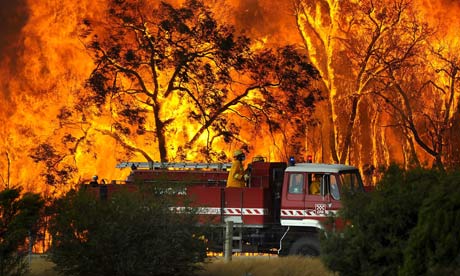• 'Hell and its fury' in Victoria, prime minister declares
• Scores of deaths exceed Ash Wednesday fires of 1983

A fire truck in front a wall of flame at the Bunyip sate forest Tonimbuk township in Victoria, Australia. Photograph: Andrew Brownbill/EPA
The death toll in the raging Australian bushfires has risen to at least 84, making it the country's worst fire disaster.
Police believe more bodies will be found in small towns razed by wildfires in the state of Victoria, the hardest hit area with more than 700 homes destroyed.
Thousands of firefighters battled for a second day today to contain the blazes, which witnesses said reached four storeys high and raced across the land like speeding trains, spewing hot embers as far as the horizon. The most serious fires are burning north of the Victorian capital, Melbourne.
The army was being deployed to help out and the country's prime minister, Kevin Rudd, announced immediate emergency aid of A$10m (£4.5m).
"Hell and its fury have visited the good people of Victoria," said Rudd on a visit to the disaster zone. "The nation grieves with Victoria."
"It went through like a bullet," Darren Webb-Johnson, from the small rural town of Kinglake, told Sky TV. "The service station went, the takeaway store across the road went, cylinders [exploded] left, right and centre, and 80% of the town burnt down to the ground."
Many of those confirmed dead were trapped in cars trying to flee, while state broadcaster the ABC showed pictures of the small town of Marysville razed.
"Marysville, which was one the loveliest townships in Victoria, if not Australia, has just about been wiped out," said Ivor Jones, a pastor whose own home in the town was destroyed.
The fires are burning around towns about 50 miles (80km) north of Melbourne, hitting both semi-urban and rural areas. More than 20 people were being treated for serious burns, local officials said.
"These fires won't be out for some days," said John Brumby, the premier of Victoria, as he appealed for blood donations for burns victims. "It's about as horrific as it could get," he said.
At the town of Wandong, about 30 miles north of Melbourne, one survivor said he had found the body of a friend in the laundry of a burned-out house. Another survivor, 65-year-old Rosaleen Dove, said she had fought successfully for seven hours with her husband to defend her home on Saturday. "We made it. I never thought I could jump fences so quickly," she said.
All of the deaths, confirmed and suspected, are believed by police to have been yesterday. Police said 12 were people killed around Kinglake, the worst-affected area so far known.
Marie Jones said she was staying at a friend's house in the town when a badly burned man arrived with his infant daughter, saying his wife and other child had been killed.
"He was so badly burnt," she told the Melbourne Age website.
"He had skin hanging off him everywhere and his little girl was burnt, but not as badly as her dad, and he just came down and he said: 'Look, I've lost my wife, I've lost my other kid, I just need you to save [my daughter]'."
Fires were still burning across about 770 sq miles (2,000 sq km) in areas north of Melbourne, with a few towns still under threat, the ABC said on its website. Brumby said 26 fires remained out of control in Victoria.
Bushfires are an annual natural event in Australia, but this year a combination of scorching weather, drought and tinder-dry bush has created prime conditions and raised pressure on the government's climate change policy.
Australia's previous deadliest bushfires were the so-called Ash Wednesday fires in 1983 when 75 people were killed and more than 3,000 homes destroyed in the southern states of Victoria and South Australia.

No comments:
Post a Comment